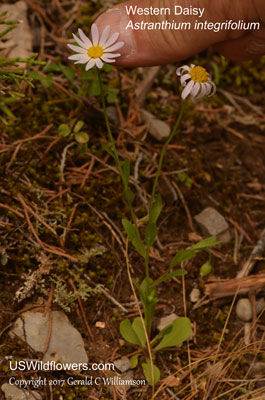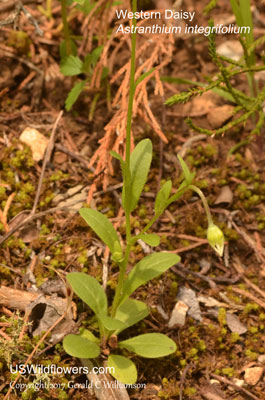Wildflowers of the United States | |||||||||||||
| |||||||||||||
Astranthium integrifolium - Western Daisy, Entireleaf Western Daisy, Eastern Western Daisy. | Astranthium is a small genus of about a dozen species primarily of Mexico, but three species have ranges within the United States - Astranthium integrifolium, Astranthium ciliatum (Comanche Western Daisy), and Astranthium robustum (which is endemic to Texas, and is known as the Texas Western Daisy.) While in the distant past, all three species have been considered subspecies to A. integrifolium, the multi-stemmed A. robustum has long been separated from the other two, single-stemmed species. Relatively recently, in 2005, Guy L. Nesom published the widely-accepted paper (see bibliography below) describing the rationale to consider Astranthium integrifolium ssp. ciliatum to be a separate species, classified as Astranthium ciliatum. My interpretation / summary of the differences between the two species:
Since these characteristics are less than obvious to most of us, and may require either waiting on seeds or pulling up the plant (strongly discouraged!), here's an easier technique - A. ciliatum occurs west of the Mississippi River - A. integrifolium to the east. While the specimen here was photographed in Tennessee and is therefore Astranthium integrifolium, I am including this plant in the lists for the states west of the Mississippi to help folks looking for wildflower identification in those states. Since the USDA still lists these species as one, the map shows the range for the combination of both species. It also shows it as being in North Carolina; according to Weakley, that was based on an erroneous report and it is not known in that state. Astranthium integrifolium is found in AL, GA, KY, MS, TN, WV Astranthium ciliatum is found in AR, KS, MO, OK, TX Astranthium robustum is found in TX Leave comments on Astranthium integrifolium at this link.   Blue=Native; Grey=Introduced Map from USDA Plants Database: USDA, NRCS. 2017. The PLANTS Database (http://plants.usda.gov, 08 May 2025). National Plant Data Team, Greensboro, NC 27401-4901 USA. Search Our Database: Enter any portion of the Scientific, Common Name, or both. Do a general Google search of the entire site: #ad
| #ad
| | ||||||||||
|
Commercial / Cookie Notice Looking for Wildflowers for a specific state? Check here: | |||||||||||||
|
| |||||||||||||



